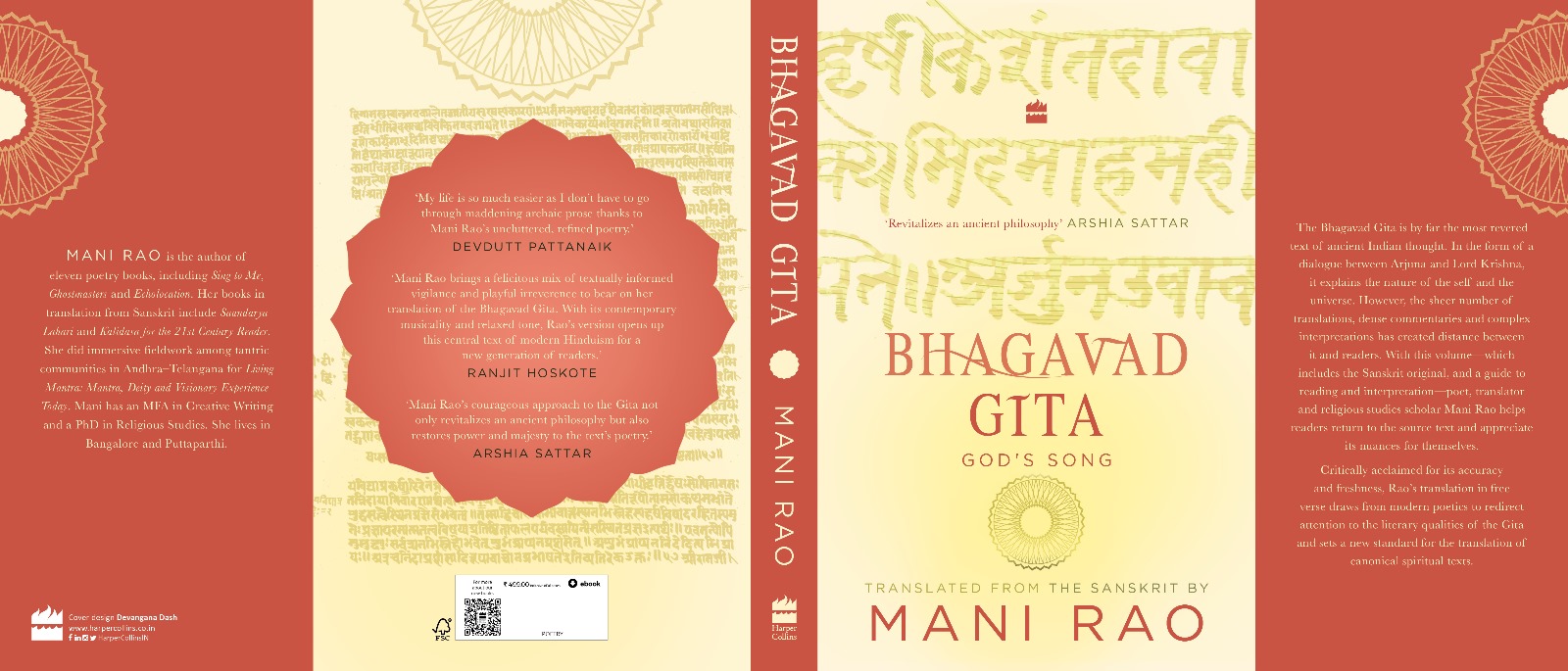Does the Gita Advocate Violence?
It seems odd to think that Krishna would urge anyone to actually kill people. In the Gita, Krishna tells Arjuna to go ahead and fight, and persuades him that he would not actually be killing anyone, because they are all already dead, and ‘that which has the body’ is immortal. (Arjuna does not ask—if I am really not killing anyone when I kill them, why kill them at all?) Moreover, Arjuna is asked to fight his friends and relatives, people with whom he has grown up and people he cares about. Arjuna’s refusal to fight tells us that he is a sensitive human being who values life and cares for relationships.
The first (and obvious) response to this problem is to recapitulate the narrative context. In the backstory, there has been much injustice. Peace talks having failed, the only way to restore righteousness is to go to war. Arjuna has to fight his own family members—and this is also a way to illustrate that we must stand up for righteousness even if it means going against people who are dear to us. Another response to the problem is to think of the war as an allegory. Gandhi had such a point of view: he saw the war of the Mahabharata as the war going on in our selves between the forces of good and evil.
My own solution has been to look at what Krishna recommends when he speaks more broadly, and to look for his assessment of violence. What is the sleight of hand that allows Arjuna to fight in battle and yet follow an ideal path? Chapter 16, where Krishna describes divine and demonic natures, provides clues. Stanzas 16.1 to 16.3 are one unit:
śrībhagavānuvāca
abhayaṃ sattvasaṃśuddhirjñānayogavyavasthitiḥ |
dānaṃ damaśca yajñaśca svādhyāyastapa ārjavam || (16.1)
This translates to: Fearlessness, goodness, purity, steady with knowledge and yoga, charity, self-control and yajnas, self-study, austerity, uprightness…
ahiṃsā satyamakrodhastyāgaḥ śāntirapaiśunam |
dayā bhūteṣvaloluptvaṃ mārdavaṃ hrīracāpalam || (16.2)
This translates to: Non-violence, truth, lack of anger, renunciation, pacifism, non-slander, compassion for all living beings, absence of greed, gentleness, modesty, absence of fickleness…
tejaḥ kṣamā dhṛtiḥ śaucamadroho nātimānitā |
bhavanti saṃpadaṃ daivīmabhijātasya bhārata || (16.3)
This translates to: Radiance, endurance, courage, purity, non-betrayal, not too much pride—these are the assets/wealth of those who are born to a divine destiny.
It is clear from the above stanzas that the Gita considers non-violence divine, and violence, demonic. How, then, is it possible for Arjuna to be asked to go to war? Is he being asked to be demonic? Krishna spells out the duties of each varna, and says that kshatriyas do not flee in battle.
śauryaṃ tejo dhṛtirdākṣyaṃ yuddhe cāpyapalāyanam |
dānamīśvarabhāvaśca kṣātraṃ karma svabhāvajam || (18.43)
This translates to: Heroism, radiance, courage, skill, not fleeing in battle, charity, and the spirit of being in charge—these are the natural duties of kshatriyas. Arjuna is a kshatriya, a warrior, and participating in a war is his duty. However, he is also told how to participate in battle. The answer to this is throughout the Gita, in the idea of conducting one’s duty without attachment.
niyataṃ saṅgarahitamarāgadveṣataḥ kṛtam |
aphalaprepsunā karma yattatsāttvikamucyate || (18.23)
This translates to: The action that is controlled and detached, done without desire or hatred, with no wish for results, that is a sattvic action. An elaborate system of ‘gunas’ (qualities) is presented in the Gita. The material world is made of a combination of the qualities of sattva, rajas and tamas. People’s characteristics depend on which guna is predominant in them—and everything from diet preferences to kinds of rituals and charity are governed by these gunas. Among the gunas, sattva leads to happiness. Krishna asks Arjuna to leave aside feelings of hatred and violence, to not seek the fruit of action, and to do his duty. These are sattvic according to Krishna’s own exposition, even though Arjuna was born in the kshatriya varna.
A reader may be troubled by these concerns and choose to reject the Gita entirely. However, considering the depth of wisdom and the range of ideas contained in the Gita, I believe, such a rejection would be a colossal loss. Especially because Krishna says that his message is not a commandment or decree.
NOT A DECREE
At a public forum, once, someone in the audience asked me if I thought Gita was authoritative, and if yes, how did I reconcile the statements about varna. I explained my reasoning, and finally added—if you think God gave us an authoritative Gita, did he also not also give us the intelligence to think? Reason has a respectable place in the Gita. There are many words for the mind in Indian conceptions—buddhi, chitta and manas are some of them. ‘Buddhi’ is typically associated with reason, the rational mind, and with commonsense. Gita also mentions samkhya, which is one of the schools of Indian philosophy. Stanza 2.39 first introduces the term ‘buddhi’ as part of ‘buddhi-yoga’.
eṣā te’bhihitā sāṅkhye buddhiryoge tvimāṃ śṛṇu |
buddhyā yukto yayā pārtha karmabandhaṃ prahāsyasi ||
This translates to: This is declared in samkhya to you. But listen to this, about buddhi-yoga, Arjuna: When you are joined with buddhi, you avoid the bondage of karma.
Here, the reader may jump to the conclusion that everything that has been said up until then refers to samkhya, and that now Krishna is about to impart something about the path of ‘buddhi-yoga’. A quick review of samkhya philosophy, however, reveals that it does not really seem to have much to do with explaining the nature of atman. Instead, it is a dualistic system that explains the material world as the result of the interaction of ‘purusha’ and ‘prakriti’—and this concept is, in fact, covered later in the Gita. Moreover, samkhya does not call for the presence of a divine entity, Ishvara, and that again seems at odds with the Gita. A simple way to understand the reference is that it could have been an early form of samkhya philosophy, or simply a more generic word that means ‘philosophy’, one which Arjuna would have studied. Understood this way, we are no longer caught up in the specifics of the reference. Instead, we begin to understand it as an official and formal system of philosophy or doctrine, and by contrast, ‘buddhi’ becomes an active application of Arjuna’s own intellect. This also works within the context of the next few stanzas, 2.42 to 2.46, in which Krishna speaks about the limitations of vedic information. This section ends with:
yāvānartha udapāne sarvataḥ saṃplutodake |
tāvānsarveṣu vedeṣu brāhmaṇasya vijānataḥ || (2.46)
This translates to: As much use there is for a well when water is plentiful everywhere; similarly, in all the vedas, for a brahmin who knows.
‘Vijānataḥ’ is also derived from ‘jñā’ (to know), and here, Krishna has pointed out the difference between samkhya and the application of one’s own mind, and Vedas and the person who already has knowledge. Simply put, Krishna is asking Arjuna to think for himself. Krishna then proceeds to talk instead about a focus on action without the desire for the results of actions. Those who think for themselves ought to figure out that the consequences and results are not in their control anyway.
DO AS YOU WISH
Finally, despite all of Krishna’s exhortations and recommendations, he gives Arjuna the choice to accept or reject them in 18.63—‘yathecchasi tathā kuru’ (do as you wish). The Gita is not a decree or a commandment.
The views expressed in this article are the author’s own and do not necessarily reflect Fair Observer’s editorial policy.
Support Fair Observer
We rely on your support for our independence, diversity and quality.
For more than 10 years, Fair Observer has been free, fair and independent. No billionaire owns us, no advertisers control us. We are a reader-supported nonprofit. Unlike many other publications, we keep our content free for readers regardless of where they live or whether they can afford to pay. We have no paywalls and no ads.
In the post-truth era of fake news, echo chambers and filter bubbles, we publish a plurality of perspectives from around the world. Anyone can publish with us, but everyone goes through a rigorous editorial process. So, you get fact-checked, well-reasoned content instead of noise.
We publish 2,500+ voices from 90+ countries. We also conduct education and training programs
on subjects ranging from digital media and journalism to writing and critical thinking. This
doesn’t come cheap. Servers, editors, trainers and web developers cost
money.
Please consider supporting us on a regular basis as a recurring donor or a
sustaining member.
Will you support FO’s journalism?
We rely on your support for our independence, diversity and quality.





Comment